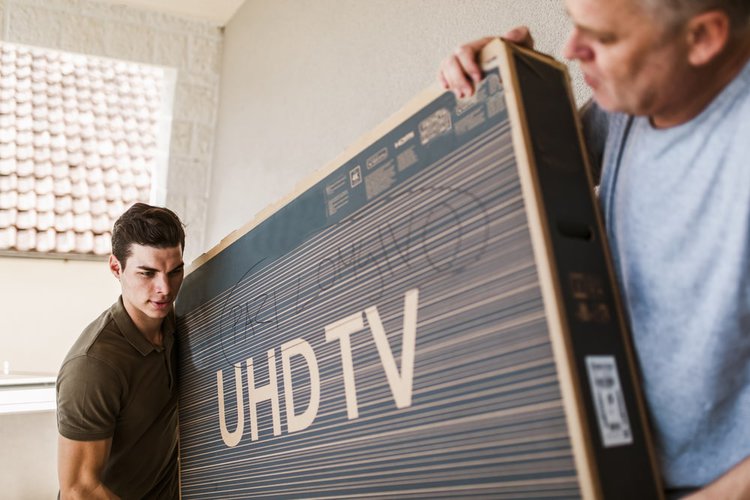How to Transport a 75-Inch TV: Box-Free Solutions

What To Know
- Detaching accessories, cleaning the TV, labeling parts, and securely packing the TV using blankets, bubble wrap, and packing tape are key steps to protect the TV during transport.
- Choosing the right vehicle (truck or van), positioning the TV correctly according to its type (plasma TVs should be upright), securing it in the vehicle, and protecting it from extreme temperatures
This guide will equip you with essential tips and strategies for transporting a 75-inch TV, ensuring it arrives at its destination in perfect condition.
We’ll delve into practical solutions tailored for these sizable screens, making your task less intimidating.
Now, let’s get started on making the journey of your 75-inch TV a smooth and secure one.
Quick Navigation
- Materials Needed
- 1. Detach Any Accessories
- 2. Clean the TV
- 3. Label Everything
- 4. Pack the TV and Accessories with Proper Packaging Materials
- 5. Carry the TV Using an Appliance Dolly
- 6. Choose the Right Vehicle
- 7. Position the TV According to Its Build
- 8. Secure the TV
- 9. Keep the TV Away from Extreme Temperatures or Humidity
- 10. Get Insurance
- 11. Hire Professionals
Materials Needed
Before diving into the tips for transporting a 75-inch TV, let’s first look at the materials you’ll need.
Ensure that you have or purchase all of the following items to be totally prepared:
- Screwdriver
- Electronic wipes or microfiber cloth
- Silica gel packets
- Moving blankets
- Ratchet straps
- Cable ties
- Packing tape
- Bubble wrap
- Box cutter
- TV or wardrobe box
- Tissue paper
- Cable organizers
- Stair-climbing appliance dolly
- Window tint kit
And, of course, you’ll need your 75-inch TV !
Once you have everything mentioned above, you can continue by following our advice below.
1. Detach Any Accessories
Before you start packing, you will first need to detach any accessories your TV may have.
This includes the following:
- HDMI cables
- Audio cables
- USB cables
- The TV antenna (if you have a digital, indoor antenna)
- The TV stand or the TV mount
- The TV base
The cables and antenna can simply be unplugged from your TV.
You might need to unscrew some components, such as the TV stand, the TV mount, or the TV base, though, this is dependent on your TV and setup.
If screws come with any of the pieces, be sure you don’t lose any. To be safe, keep them in small containers or bags that you can easily pack with your TV.
2. Clean the TV
Next, you will want to clean your TV, along with any pieces that will be packed with it.
This may seem a bit silly since you’re going to be moving, and it will probably get dirty along the way, but it’s actually an important step.
When moving a TV, dust and debris can sometimes damage it – especially the screen, which is more vulnerable to scratches. And since you’ll be packing your TV, the dust and debris will be trapped inside with your electronics.
To keep the risk of scratching as low as possible, use electronic wipes or a microfiber cloth to wipe down your TV and its accessories.
3. Label Everything
Now that you’ve disassembled your TV and cleaned all the pieces, it’s time to start labeling.
Like cleaning, this may seem like an unimportant step, but if you don’t label, you may end up regretting it later. Knowing which components do what will make it simpler to put everything back together.
Be sure to label each cable with the TV port it connects to and label each bag of screws with the TV part it goes with.
If you don’t want to deal with the hassle of labeling every single item, you could go the easy route and take a picture with your phone. Then, you can edit the picture with text labels for each piece.
4. Pack the TV and Accessories with Proper Packaging Materials
The next thing you need to do is pack everything. This can get a bit complicated, so we’ll break it down into steps.
You can follow these procedures to pack your TV:
- Take one or more weighted blankets and wrap them around the TV.
- Wrap the TV with packing tape, with the sticky side facing away from it.
- Make sure the bubble wrap adheres to the tape as you roll it around the TV.
- If you have the original box: Put the wrapped TV inside the box it came in.
- If you don’t have the original box: Take one or more wardrobe boxes and use the box cutter to shape it for your TV.
- To remove any moisture, insert a few packets of silica gel into the box.
- Close the box and use packing tape to seal any openings.
Now that you’ve packed your TV, it’s time to pack the accessories.
For the TV base, TV mount, TV stand, and remote, you can wrap them with packing tape and roll bubble wrap around them.
For all wires, cables, and cords, you can wrap them in tissue paper – or, at the very least, use cable organizers to keep them neat.
When all of the accessories are properly protected, you can pack them into a wardrobe box and seal it shut with packing tape.
5. Carry the TV Using an Appliance Dolly
Your TV is packed up and ready to go – but now comes the struggle of getting it to your mode of transport.
Technically, this can be done with nothing but pure manpower. If you are strong, or if you have friends or hired help, you could carry the TV down to the moving vehicle.
But if you want to be extra careful, it would be best to use an appliance dolly that can safely hold the weight of your TV.
If you live in an apartment or a two-story house, a dolly will also help transport the TV down the stairs with minimal bumps.
Simply take your TV and load it onto the dolly. Regular TVs can be laid flat, while plasma TVs must be stood upright to avoid damaging the screen.
Use a ratchet strap or cord to secure the TV to the dolly and carry it to your vehicle.
6. Choose the Right Vehicle
Before you load your TV into the moving vehicle, check to ensure you’ve picked the right size vehicle for transporting it.
In general, the best vehicles for moving a 75-inch TV are pickup trucks, box trucks, minivans, and vans. There are different pros and cons for trucks and vans.
Trucks are great in terms of space. You don’t have to worry about trying to fit your TV because they have a big trunk.
However, a large amount of space also makes it trickier to secure the TV.
You will need to use some kind of platform, like a wooden pallet, to stabilize the TV from underneath, then carefully secure both the platform and the TV with straps.
And if your truck has an open trunk, you’ll also need to worry about covering it properly to protect it from heat and rain. This may be particularly tricky if your TV has to stand upright and won’t fit neatly under a tarp.
Vans have less space than trucks, but the cozy fit can actually help you keep the TV from jostling around.
For minivans, you can simply fold down a few seats and sit the TV upright in the now available space. Because the TV is forced to sit upright, this is a great vehicle for plasma TVs, which have to sit upright anyway.
In addition, you can use seats in front of the TV to help keep it in place by tilting them backward.
Another benefit of using vans is that you can keep the TV inside the car, which automatically provides protection from heat and rain.
7. Position the TV According to Its Build
Now it’s time to place your TV in your moving vehicle. This will primarily depend on how your TV is constructed.
Most TVs are best transported lying down on their back. NEVER transport a TV lying down on its screen.
But if your TV is a plasma TV, it’s very important to note that you will need to transport it standing upright. Otherwise, the glass screen may get damaged during transit.
8. Secure the TV
Congratulations, you’ve gotten the TV packed and ready to go – but now you need to secure it in the moving vehicle so that it doesn’t jostle around while in transit.
This can be done in several ways.
The first way is to use straps that may come with your vehicle. These are typically underneath the backseat or in the trunk.
If your moving vehicle doesn’t come with any straps, you can buy ratchet straps, which can be used both inside and outside a vehicle.

Once you have your straps, tie them around your TV and fasten them on something secure, like the door handles or the seatbelts.
And if you want extra security, you can use cable ties to further secure any cables or straps you use.
9. Keep the TV Away from Extreme Temperatures or Humidity
Now that you’ve secured your TV, you need to make sure it’s protected from extreme temperatures or humidity during transit.
This is especially important if it’s going to be a long drive or if the TV is directly under the sun.
If the TV is inside the car, you can protect it from the heat by temporarily tinting your windows or by covering the windows with shades.
If the TV is outside the car, you can protect it from the heat by covering it with a blanket. But if you suspect it might rain, you should cover it with a waterproof tarp instead.
10. Get Insurance

This isn’t exactly necessary, but this is a great step to take – especially if you’re transporting your TV over a long distance or hiring a third party to do it for you.
If so, you should contact your insurance provider to purchase insurance. This way, you can insure your TV against any damage sustained while in transit.
This will cost you a bit extra, but considering how much of an investment a 75-inch TV is, you can view it as (quite literally) protecting your investment.
11. Hire Professionals

Of course, you could avoid this hassle by hiring a professional moving or freight carrier service. Although it would cost more money, you would spend less time and effort if you did this.
If you do decide to go this route, be sure to inform the service of your TV’s weight, size, and model. This will guarantee that they can move it without causing any unintentional damage.
Meet Vance. He’s a proud dad, a seasoned Electronics Engineer, and an avid tech lover. His proficiency in electronics and troubleshooting skills were instrumental in crafting Pointer Clicker. Vance is passionate about simplifying tech for those who aren’t well-versed in it.

